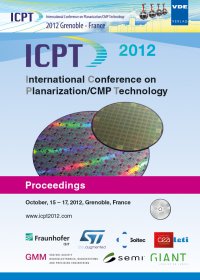A Novel Evaluation Method of Polishing Slurry Flow Using Digital Image Processing - Mechanical Polishing for Sapphire Using Diamond Slurry
Conference: ICPT 2012 - International Conference on Planarization / CMP Technology
10/15/2012 - 10/17/2012 at Grenoble, France
Proceedings: ICPT 2012
Pages: 5Language: englishTyp: PDF
Personal VDE Members are entitled to a 10% discount on this title
Authors:
Uneda, Michio; Fukuta, Yuya (Graduate School of Kanazawa Institute of Technology, 7-1 Ohgigaoka, Nonoichi, Ishikawa, 921-8501, Japan)
Hotta, Kazutoshi; Sugiyama, Hiroyasu (Fujimi Incorporated, 1-8, Techno Plaza, Kakamigahara, Gifu, 509-0109, Japan)
Abstract:
In the mechanical polishing, the slurry mixed free abrasive grains are supplied to the contact surface between the workpiece/ platen. The mechanical polishing characteristics are affected by the actual slurry flow in the contact surface between the workpiece/ platen. Most of previous studies on the slurry flow were focused only qualitative evaluation based on the observed image, but none of them were demonstrated the quantitative evaluation. Furthermore, uniform slurry exchange is required to improve the polishing characteristics. In this study, we propose a novel quantitative evaluation method of the slurry flow using the digital image processing, and we also discuss the effect of rotational speeds of the workpiece/ platen by using the proposed following parameters; (I) the vector diagrams of the slurry flow in the contact surface and (II) the slurry inflow/ outflow ratio to the contact surface. The results are summarized as follows. (1) A novel method and parameters can be used to evaluate the slurry flow quantitatively. (2) The slurry flow is depended on the rotational speeds of the workpiece/ platen, the effect of the centrifugal force on the slurry flow dramatically increases with an increase in the rotational speed over 40 min-1. (3) The inflow ratio to the contact surface and its region decrease with an increase of the rotational speed. Keywords: Slurry flow, Quantitative evaluation, Digital image correlation method, Inflow/outflow ratio, Contact surface.


